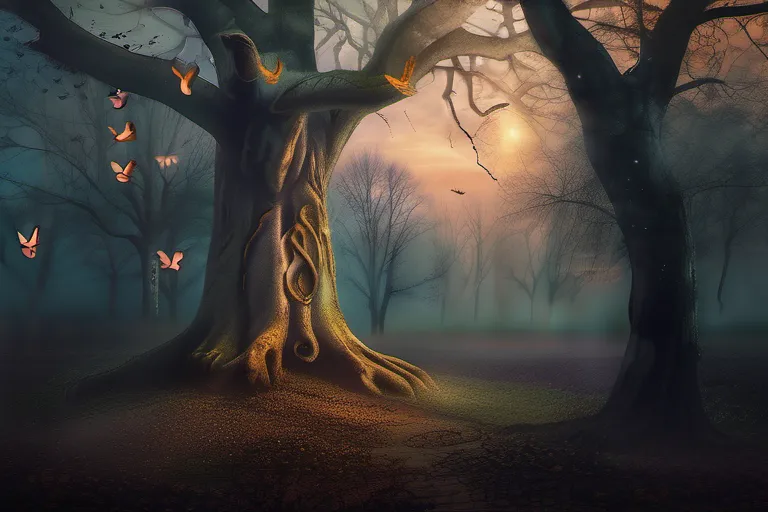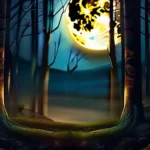Explore the roots, beliefs, practices, and evolution of ancient Slavic paganism.
Delve into the fascinating world of Slavic paganism, a spiritual tradition that has shaped the lives of millions for centuries. In this article, we will explore its origins, key beliefs, rituals, and how it evolved over time.
The Roots of Slavic Paganism
The origins of Slavic paganism are like peeling back layers of an onion, revealing complex and intertwined histories that stretch far into prehistory. Did the roots of this ancient faith stem from the Proto-Indo-European religion? Or did they evolve independently in their unique geographic setting?
Imagine a vast plain where nomadic tribes roamed, living in harmony with nature and the elements. These early Slavs believed in a pantheon of gods who mirrored aspects of their daily lives. The earth was fertile, rich with crops and resources, but also harsh, testing the resilience of its people. This dual nature of both abundance and hardship is reflected in many Slavic deities.
How did these beliefs evolve as distinct Slavic tribes began to form? Were there specific events or migrations that shaped their religious practices and deities? Consider the mythological figure of Perun, often associated with thunder and lightning. Could he be a reflection of the primal fear of storms, or perhaps a symbol of the powerful forces of nature that demanded respect?
Their rituals and ceremonies were deeply intertwined with the cycles of the seasons, agricultural practices, and the natural world. Were these rituals primarily about seeking fertility for crops and livestock, or did they also serve to appease ancestral spirits? It’s fascinating how the concept of svetovid, a god associated with light and knowledge, reflects both enlightenment and the darkness that often follows.
Through it all, Slavic paganism was not just about worship; it was a way of life. Every aspect from daily routines to major festivals celebrated in spring or autumn echoed these beliefs, weaving them into the very fabric of society. How did this interwoven tapestry influence the social and cultural structures of early Slavic communities?
As we delve deeper into the origins and evolution of Slavic paganism, one cannot help but wonder how much of this ancient wisdom has been preserved in modern traditions or lost to the sands of time. What lessons can contemporary societies learn from these early beliefs about harmony with nature and community cohesion?
The journey through the roots of Slavic paganism is a voyage into a world where every day held spiritual significance, and the divine was an ever-present force in everyday life.
Key Beliefs and Deities
As we delve into the heart of Slavic paganism, it’s impossible not to wonder about the pantheon that guided these ancient peoples. Who were these deities that shaped their lives and beliefs? What roles did they play in daily existence? And how did these gods and goddesses evolve over time?
Let’s start with Dazhbog, often referred to as the god of light, wealth, and fertility. Imagine him as a sun deity, radiating warmth and prosperity into every aspect of life. Could he be seen as a symbol of hope and abundance in times of hardship? And what about Perun, the thunder god, with his might and power over storms and battles? Picture him riding through the skies on his chariot, wielding a lightning bolt that strikes fear and respect alike.
Then there’s Stribog, the god of air and wind. Think of him as the gentle breeze that whispers secrets or the fierce gusts that bring change. And Lada, goddess of love, beauty, and youth – envision her bringing joy and harmony to relationships and communities.
These deities were not just abstract concepts; they were integral parts of daily life. Worshippers would offer sacrifices, perform rituals, and seek their favor in various aspects of existence. Offerings ranged from food and drink to precious metals, with the hope that these gifts would ensure good fortune or protect against evil.
But how did this pantheon come into being? Legends tell us that they emerged from myths and stories passed down through generations, evolving as Slavic tribes formed distinct cultures. These deities weren’t static; their attributes and roles shifted with societal changes, reflecting the complex interplay of nature, human experience, and spiritual beliefs.
So, how did these gods and goddesses shape not just religious practices but also social structures? How did they influence laws, art, and even folklore? The answers to these questions lie in the rich tapestry of Slavic history and mythology, waiting to be uncovered. Join us as we continue our exploration into the rituals and practices that brought these deities to life in ancient times.
Rituals and Practices
Rituals and practices were the heartbeat of ancient Slavic paganism, much like the pulse that beats through our veins today. How did these rituals evolve over time? What was their purpose beyond mere worship?
Imagine a village gathered around a bonfire on a frosty night in winter, their voices rising with the crackling flames as they invoke their svetovid, or light god. This scene is more than just a cultural ritual; it’s a lifeline connecting past and present. What exactly were these offerings meant to achieve? Were they simply acts of appeasement, or did they hold deeper meanings?
Slavic festivals like Mokosh and Dumebi, dedicated to fertility and the changing seasons, were not just celebrations but essential practices for ensuring a bountiful harvest. These rituals often involved intricate dances and offerings of food or drink, much like the modern-day festivals we celebrate today with feasts and festivities.
Divination was another crucial practice in Slavic paganism, used to seek guidance from deities or spirits. Techniques such as reading animal entrails or interpreting dreams were not just superstitions but integral parts of daily life. How did these practices influence decisions about marriage, travel, or even war? The answers lie in the intricate web of beliefs that shaped ancient Slavic societies.
Through festivals, offerings, and divination, the Slavs wove a tapestry of rituals that bound their communities together, much like threads in a quilt. These practices were not just religious acts but social glue, ensuring harmony and unity within the community. The evolution of these rituals reflects the dynamic nature of ancient Slavic societies as they adapted to changing circumstances.
As we delve deeper into the world of Slavic paganism, it becomes clear that these rituals weren’t merely superstitious practices; they were the lifeblood of a culture deeply intertwined with its natural surroundings and deities. How did these practices evolve over time, and what can they teach us about human societies and their spiritual expressions?
The Spread of Slavic Paganism
As Slavic pagan beliefs spread across Europe, they encountered other cultures and adapted to changing circumstances. This journey was not just geographical but also cultural and spiritual, much like a river winding through diverse landscapes, picking up new elements along its path.
Imagine a group of wandering traders, carrying tales of their gods and myths as they moved between settlements. These stories mixed with the local legends, creating a rich tapestry of beliefs that was both familiar and unique to each region. For example, as Slavs settled in what is now Poland, they found themselves surrounded by Germanic tribes. The interaction wasn’t just one-way; the gods of thunder and war from Germanic myths began to blend with the Slavic god Perun, creating a deity that encompassed both elements.
The spread also saw the merging of pagan practices with Roman Catholic influence, particularly after the 9th century. This was evident in how Slavic deities like Baba Yaga began to take on new roles, sometimes as guardians or guides within Christian narratives. It’s a bit like adding spices to a dish; each ingredient brings its own flavor but together they create something unique and more complex.
In areas where the influence of other cultures was strong, Slavic paganism had to adapt quickly. For instance, in parts of Russia, where Varangian traders established rule, pagan practices were often suppressed or transformed into folklore and legend. This is reminiscent of a tree that adapts its roots when planted in different soil; the essence remained, but the form changed.
The spread of Slavic paganism also involved interactions with other nomadic groups like the Huns and later the Mongols. These encounters brought new concepts of divinity and sacrifice into the mix, influencing rituals and ceremonies. It’s as if these different cultures were seeds planted in a garden; each added its own color and texture to the existing landscape.
The path of Slavic pagan beliefs was not linear but rather a complex network of interwoven traditions and influences. As it spread across Europe, it transformed with every step, creating a diverse yet interconnected world of gods, rituals, and stories that continue to fascinate historians and scholars today. This journey is much like the tale of a ship sailing through uncharted waters, guided by the stars but always open to the winds of change.
The Christian Conversion and Survival of Slavic Paganism
As we delve into the Christian conversion and survival of Slavic paganism, it’s almost as if you’re stepping back in time, watching the religious landscape of Eastern Europe shift under the weight of history. How did this ancient belief system, so deeply intertwined with nature and community, fare against the relentless march of Christianity? The journey is both fascinating and complex.
When Slavic tribes encountered the Christian missionaries during the early Middle Ages, the outcome was not a straightforward victory for one faith over another. Instead, it was more like a delicate dance where elements of paganism survived in unexpected ways. How did the Slavs reconcile their old gods with the new ones? Were some pagan practices merely disguised as Christian rituals, or were they secretly preserved in the shadows?
One can’t help but wonder about the stories that were whispered around the hearth at night, tales of slovo (words) and boje (spirits), woven into the fabric of Slavic culture. Did these tales survive because they held a deeper truth, or were they simply folktales meant to entertain? The idea that some pagan practices might have been passed down through generations in the guise of Christian traditions is both intriguing and a little unsettling.
The survival of certain Slavic pagan beliefs and practices into modern times is a testament to their resilience. Whether it’s the veneration of Perun, the thunder god, or the celebration of Svetladi, the spring festival, these remnants of old customs continue to enrich contemporary Slavic culture. How do modern practitioners reconcile their ancient beliefs with the demands of today’s world? Are they honoring their heritage by keeping these traditions alive, or are they just trying to fill a spiritual void?
The Christian conversion and survival of Slavic paganism is like a puzzle where each piece represents a fragment of history, tradition, and human belief. By exploring this topic, we gain not only insights into the past but also a better understanding of how ancient practices continue to shape our present.
Modern Revivals and Contemporary Practices
As we journey into modern times, one cannot help but wonder: What drives people to reconnect with their ancient roots? In the realm of Slavic paganism, this revival is not just a mere curiosity; it’s a profound exploration of identity and spirituality.
In today’s world, where technology often isolates us from our natural surroundings, why do so many seek out the wisdom of old ways? The resurgence of interest in Slavic pagan traditions can be seen as a quest for authenticity and connection—a desire to find meaning beyond the digital realm. These modern revival movements are not just preserving ancient practices; they’re breathing new life into them.
The heart of this revival lies in its adaptability. Contemporary practitioners blend traditional rituals with contemporary needs, creating something both familiar and fresh. For instance, midsummer bonfires, once central to pagan celebrations, now serve as community gatherings that celebrate the solstice while incorporating modern amenities like eco-friendly fuels and social media sharing.
Their approach is also inclusive, embracing people of all backgrounds who are drawn to these practices. Is it not a beautiful thing for traditions to evolve and welcome new members? These movements have become a melting pot of diverse beliefs, fostering an environment where ancient wisdom can coexist with modern understandings.
Moreover, many revivalists focus on environmental stewardship, seeing the natural world as sacred. This approach mirrors the Pan-Slavic reverence for nature, emphasizing harmony and respect for all living things—a stark contrast to the often exploitative practices of contemporary society.
As we explore these modern revivals, it’s clear that Slavic paganism is not just a relic of the past. It’s a vibrant force shaping the spiritual landscape of today, offering a profound connection to our heritage and the natural world.
Conclusion
 By understanding the rich history and traditions of Slavic paganism, we gain a deeper appreciation for the cultural heritage of the Slavic peoples and the resilience of their spiritual practices.
By understanding the rich history and traditions of Slavic paganism, we gain a deeper appreciation for the cultural heritage of the Slavic peoples and the resilience of their spiritual practices.











